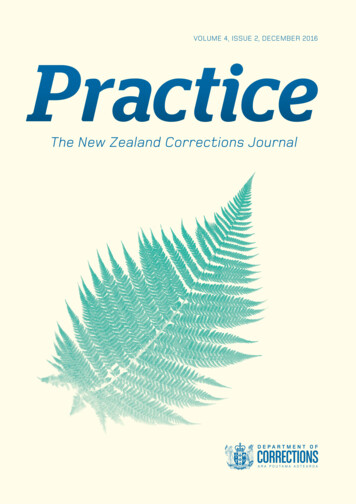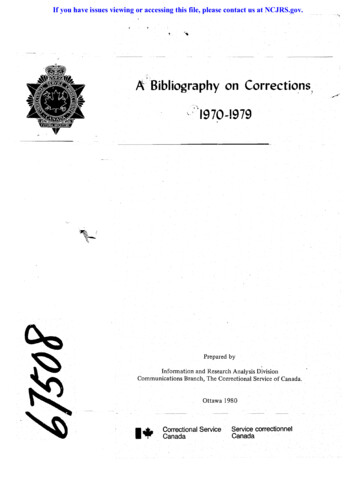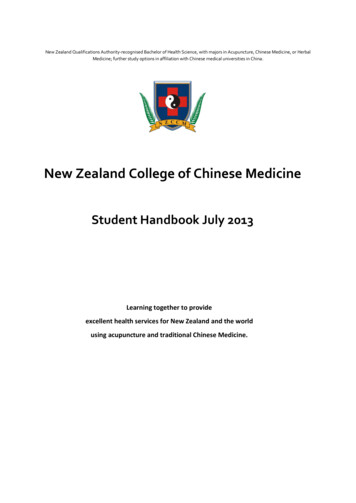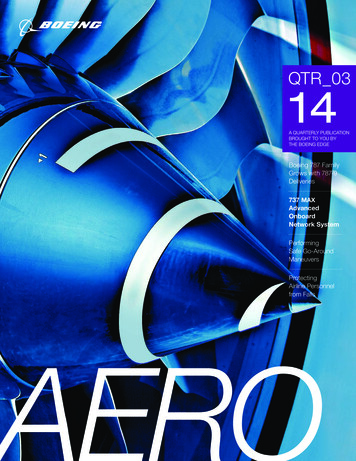
Transcription
VOLUME 4, ISSUE 2, DECEMBER 2016The New Zealand Corrections Journal
Contact detailsPractice: The New Zealand Corrections JournalDepartment of Corrections / Ara Poutama AotearoaPrivate Box 1206, Wellington, New ZealandEmail: CorrectionsJournal@corrections.govt.nzISSN 2324-4313 (Online)
ContentsEditorial.4Nova BanaghanThe Department of Corrections’ tikanga-based programmes.5Neil CampbellInnovations in reducing re-offending.9Juanita Ryan and Robert JonesThe Sentenced Prisoner Population 1980-2016: The link between policy changes and growth . 16Wayne GoodallTrauma hiding in plain view: the case for trauma informed practice in women’s prisons. 22Hannah McGlueCross-agency plan to deliver world leading interventions for people who use violencewithin their family .26Zoey HenleyTowards an understanding of female family violence perpetrators: A study of women in prison.29Marianne Bevan, Ella Lynch and Dr Bronwyn MorrisonEvidence-based principles for prison-based alcohol and drug treatment.35Dr Jillian MullenState of mind: mental health services in New Zealand prisons.38Kate Frame-Reid and Joshua ThurstonSupporting offenders into employment – a joint initiative. 42Marama Edwards and Stephen CunninghamGuided Release: A graduated pathway enabling safe and successful reintegration forlong-serving prisoners.46Anita EdmondsAukaha te Waka – the Future of Probation 2016 – 2021.48Brent ReillyAn exploratory analysis into the mortality of offenders.53Ong Su-Wuen and Ella LynchBuilding relationships to improve outcomes for youth in Corrections.61Dr Ashley Shearar and Brigid KeanBook Review: What Works in Crime Prevention and Rehabilitation.64David Weisburd, David P. Farrington, Charlotte Gill (editors) 2016Reviewed by: Kahurangi GrahamBook Review: Environmental corrections: A new paradigm for supervising offendersin the community . 67Lacey Schaefer, Francis T. Cullen and John E. EckReviewed by Dr Peter JohnstonInformation for contributors.69Practice – The New Zealand Corrections Journal – VOLUME 4, ISSUE 2: DECEMBER 20163
EditorialChanging practice; changing livesHaving only recently joined the Department of Corrections, I am constantly amazed at how dedicated the staff hereare to changing lives and improving circumstances for those with whom we work, whether this is in a prison or in thecommunity or working in partnership with contracted providers.Being editor of the Practice Journal has further reinforced for me just how far we have come on our journey ofreducing re-offending and shaping futures.This edition focuses on some key pieces of work being led by Corrections as well as initiatives being jointly led withother organisations, for example in the employment space and the family violence sector.There are a number of articles that give us insight in to how much we have achieved over the last five years, inparticular our Director Mäori, Neil Campbell’s, article on tikanga-based programmes. This article reminds us thataddressing the high rate of Mäori re-offending cannot be achieved alone and reinforces the need to collaborate withMäori groups to improve the way we design and deliver programmes.Wayne Goodall’s gem The Sentenced Prisoner Population 1980-2016: The link between policy changes and growthgenerates much food for thought. The article outlines key legislative and policy changes that have impacted on thegrowth and changing nature of the sentenced population.As Goodall’s article highlights, there are now many more people in prison for drug offences, hence the need forevidence-based alcohol and drug treatment, as outlined in the article by Dr Jillian Mullen. The relevance of theseprogrammes is highlighted by the complexity of the needs we are seeing in the youth who are sentenced to prison.Dr Ashley Shearer highlights the importance of a principled approach and the involvement of communities whenworking with young people in the prison setting.This also applies to how we work with women in the custodial environment. Hannah McGlue’s article on traumainformed practice and the article from Bevan, Lynch and Morrison on female family violence perpetrators give richinformation on understanding why women offend and how we can work differently with them to improve their lives.These articles enable us to better understand those we are working with and how we can adapt our practice so theycan make changes.I cannot stress how much I recommend you to grab this edition and read it thoroughly. It will not only enrich yourwork, it will also remind you of our commitment to changing lives and how we can all make a difference every day.Nova BanaghanDirector Quality and Performance, Service DevelopmentDepartment of Corrections4Practice – The New Zealand Corrections Journal – VOLUME 4, ISSUE 2: DECEMBER 2016
The Department of Corrections’tikanga-based programmesNeil CampbellDirector Mäori, Department of CorrectionsAuthor biography:Neil has been employed as the Director Mäori for the Department of Corrections since July 2012. Before this, he held a number ofpositions within different Mäori-focused teams including the Director Mäori Rehabilitation and Reintegration, the Manager MäoriServices (Southern Region), Partnership Manager Northern Region, and the Regional Adviser Mäori Service Development. In his21 years with Corrections, he has worked at every level of interaction with offenders including design, development and delivery ofinterventions. He currently has responsibility for the Mäori Services Team and strategic relationships with Mäori.IntroductionThe Department of Corrections is committed todelivering better outcomes for Mäori offenders andtheir whänau. It is well known that Mäori are overrepresented in all stages of the criminal justicesystem. Corrections works to reduce the rate of Mäorire-offending through the delivery of both mainstreamand tikanga-based motivational, rehabilitative andreintegrative programmes.Mainstream programmes ensure that all offenders,including Mäori, gain access to interventions that areproven to be effective. All mainstream programmesare designed to be responsive to Mäori, as a largenumber of Mäori offenders will be eligible to attendthem. We receive cultural input into the design of theprogrammes through cultural advisory groups andconsultants. We also apply a Mäori cultural frameworkwhen designing mainstream programmes so theMäori perspective is considered from the outset.Our evaluation results prove that in mainstreamprogrammes Mäori perform just as well, and in somecases better, than non-Mäori offenders.Although mainstream programmes are effectivefor Mäori, we are very aware that there is not a“one size fits all” approach to reducing Mäori reoffending. As a result, Corrections also offers tikangabased programmes, which suit some Mäori. Theseprogrammes incorporate Mäori customs and Te AoMäori (the Mäori world view). They are designed tostrengthen an offender’s cultural identity, change theirbehaviour and reduce their likelihood of re-offending.The programmes can also address cultural distortionsthat encourage offenders to misuse aspects of Mäoriculture as justification for their criminal behaviour.Corrections recognises that we cannot address thehigh rate of Mäori re-offending on our own. Accordingly,we collaborate with Mäori groups to improve the waywe work with Mäori offenders, and improve the waywe design, implement and deliver programmes. Ourdedicated Mäori Services Team is responsible fordeveloping and maintaining strong relationships withiwi (tribes), hapü (sub-tribes), kaitiaki (guardians), andother Mäori community groups. These relationshipsinclude collaborative operational agreements, formalpartnership agreements, and relationships based onTreaty of Waitangi settlement obligations.In recent years Corrections has significantly increasedthe number of mainstream and tikanga-basedprogrammes available to offenders, and also increasedour efforts to evaluate their effectiveness. There hasnever been such a high level of investment directedtowards reducing re-offending, particularly for Mäori.The development of our key tikanga-based programmesis outlined below.Motivational programmesMotivational programmes are designed to helpoffenders overcome barriers that prevent them fromparticipating in rehabilitation programmes. Corrections’key tikanga-based motivational interventions are theSpecialist Mäori Cultural Assessment, Tikanga MäoriProgrammes, and the Te Ara Mäori units.Specialist Māori Cultural AssessmentThe Specialist Mäori Cultural Assessment is a tool toaddress an offender’s responsivity and motivationalbarriers. The tool is currently available to prisoners andcommunity-based offenders in the Northern Region andat Waikeria Prison.Practice – The New Zealand Corrections Journal – VOLUME 4, ISSUE 2: DECEMBER 20165
The assessment is undertaken by independent,contracted Mäori assessors to encourage offendersto consider a culturally-enhanced pathway out ofoffending. The assessors engage in körero (talk)with the offender about who they are, how they seethemselves, what it means to be Mäori, and how thatknowledge can help them. The assessors will körerowith offenders about their place in their whakapapa(genealogy) and how to reconnect positively to it.The assessors use the findings from the assessmentto produce a detailed report that containsrecommendations for Corrections staff and theoffender. The recommendations for the offender aregenerally to engage in self-directed activities suchas researching whakapapa or registering with theirtribal authority or organisation. The recommendationsfor Corrections staff are generally to refer theoffender to activities such as the Tikanga Mäori orTe Tirohanga programmes.A 2007 evaluation of the tool found that it immediatelyimproved an offender’s motivation in areas suchas: participation in cultural programmes, learningwhakapapa, developing whänau relationships,completing rehabilitation programmes, andaddressing offending.Tikanga Māori ProgrammesTikanga Mäori Programmes comprise a range ofculturally-responsive motivational programmes foroffenders who identify as Mäori. The programmesare delivered by local providers and vary from siteto site. They are designed to motivate offenders toengage more fully in rehabilitation programmes byhelping them understand their cultural identity, and byencouraging them to embody the kaupapa (principles)and tikanga (customs) of their tipuna (ancestors).They cater to a variety of learning styles, and activitiesinclude discussion, role play, the practice of Mäoriprotocol, and kapahaka (performing arts).In 2012, Corrections sought feedback from a numberof local providers on the delivery of the programmesas part of a wider review of all interventions. Thefeedback suggested that the programmes wouldbenefit from greater consistency of purpose andapproach. As a result, Corrections worked with Mäoriprogramme experts to develop a new framework andassessment tool.The new framework, Te Ihu Waka, has been designedto ensure consistent and measurable outcomes foroffenders who participate in prison and communitybased programmes. All programmes delivered underthe framework are now structured around the fourkaupapa of manakitanga (hospitality), whänaungatanga(attaining and maintaining relationships),6rangatiratanga (autonomy) and wairuatanga(spirituality and wellbeing).Te Ara MāoriTe Ara Mäori are prison units that provide a tikangabased environment to support male prisoners instrengthening their cultural identity. This is achievedthrough the delivery of Tikanga Mäori programmes.The units are particularly beneficial to prisoners servingshort sentences who would otherwise not be eligiblefor an intervention. The units can also benefit prisonerswho are serving longer sentences by encouraging themto attend the Te Tirohanga national programme. Thefirst Te Ara Mäori was established in a 20-bed unit inManawatu Prison in 2015.In October 2016, the first Te Ara Mäori for womenwas established in an 18-bed unit at AucklandRegion Women’s Corrections Facility. We arecurrently developing another unit at ChristchurchWomen’s Prison.Rehabilitative programmesRehabilitation programmes are designed to helpoffenders address the causes of their anti-socialbehaviour, and develop strategies to prevent them fromcommitting further offences. Corrections’ key tikangabased rehabilitation interventions are the Te Tirohanganational programme, Mauri Tu Pae, and Te Kupenga.Te Tirohanga national programmeThe Te Tirohanga national programme refers to a rangeof tikanga-based services delivered in five dedicatedunits at Waikeria, Tongariro, Hawke’s Bay Regional,Whanganui and Rimutaka prisons.The history of the programmeThe Te Tirohanga units were previously known as“Mäori Focus Units”. The first Mäori Focus Unit openedin Mangaroa Prison (now Hawke’s Bay RegionalPrison) in 1997. By 2002, dedicated units had also beenestablished at the other four prisons mentioned above.In 2009, Corrections evaluated the Mäori FocusUnits and the Mäori Therapeutic Programme (whichis discussed in more detail below). In 2010/11, thetherapeutic outcomes of the units were also specificallyevaluated. The reviews found that the units provideda pro-social environment, but were not reaching theirfull rehabilitative potential. As a result, Correctionsinitiated the “Mäori Focus Unit Improvement Project” torevitalise the therapeutic model operating in the units.In order to progress the project, Corrections createda Mäori Governance Board comprising iwi-mandatedrepresentatives from the areas where the five unitswere located. The Board worked alongside thePractice – The New Zealand Corrections Journal – VOLUME 4, ISSUE 2: DECEMBER 2016
project executives, being the director Mäori and theregional commissioners from the Central and LowerNorth regions. In December 2012, the Board and theproject executives approved the revised Te Tirohangaprogramme. In October 2013, the new programmewas implemented at Waikeria, Tongariro, and Hawke’sBay Regional prisons. The programme was laterimplemented at Rimutaka Prison in January 2014 andat Whanganui Prison in April 2014.Te Tirohanga in operationTe Tirohanga is a six phase programme that includeswhänau support, education and rehabilitation services.In developing the programme, the Mäori GovernanceBoard identified kaupapa values that provide the basisfor interactions within the units. Staff and prisoners areexpected to model these values on a daily basis.The five Te Tirohanga units contain 258 beds in total;however, the rolling nature of the programme meansthat, if quarterly intake is at a maximum, 172 prisonerswill complete it each year. Forty-six prisoners areexpected to begin the first phase of the programmeevery quarter across all five sites.Whänau support is primarily delivered by pouarataki (previously whänau liaison officers), who areresponsible for assessing and improving the quality ofthe relationship between prisoners and their whänau.Pou arataki work with each prisoner to conduct awhänau assessment in the first three months of theprogramme. The assessment categorises relationshipsinto three distinct groups: whänau toiora (positive),whänau tawhiti (disengaged) and whänau kore (nonexistent). Pou arataki then support prisoners assessedas having whänau kore or whänau tawiti relationshipsto reconnect or establish positive relationships withtheir whänau.The programme is designed to help prisoners alter thebehaviours that led to their offending, and to help themdevelop strategies for maintaining positive change.The programme includes: constructing an “offencemap” which outlines the actions and decisions that ledto their offences; challenging attitudes that supportoffending; guidance on managing emotions, conflict andrelationships; and developing safety plans.The Mauri Tu Pae programme was previously knownas the Mäori Therapeutic Programme. In 2000, theMäori Therapeutic Programme was piloted at theMäori Focus Unit in Hawkes’ Bay Regional Prison. Theprogramme was designed as a culturally enhancedrehabilitation intervention to better meet the needs ofoffenders participating in the units. Soon after the pilot,the programme was expanded to all other Mäori FocusUnits, and was also later implemented at NRCF.The Mäori Therapeutic Programme was notoriginally considered equivalent to, or as effectiveas, the Department’s mainstream Medium IntensityRehabilitation Programme (MIRP). In 2012/13,Corrections worked with the Mäori service providers toreview the programme, which led to the content beingstrengthened and the duration being extended. Therevised Mauri Tu Pae programme is now consideredequivalent to the MIRP.Te KupengaTe Kupenga is a highly tailored multi-agency approachto reducing intergenerational whänau offending. Theprogramme focuses on collaboration and relationship– building to develop and achieve goals. Whänauare responsible for establishing their own goals andidentifying the support people to help achieve thosegoals. Agencies help with processes to ensure thesupport is effective.Education services are primarily provided by TeWananga o Aotearoa, who are contracted to deliverthe Level 2 National Certificate in Mäori withinthe units. The certificate is intended to improve aprisoner’s literacy and numeracy skills, strengthentheir cultural identity and provide a pathway towardsvocational qualification.The programme started in 2014 and is currentlyin place in Kaikohe and Manurewa. At Kaikohe, forexample, three Corrections staff established and ledthe multi-agency approach to providing rehabilitativeservices to a whänau of two parents and their sixchildren, all of whom were either on a community orprison-based sentence.As discussed below, rehabilitation services areprimarily delivered in the units through the MauriTu Pae programme. Prisoners who meet the eligibilitycriteria will also attend a three-month intensivealcohol and other drug treatment programme at theTe Tirohanga unit at Whanganui Prison.Although Te Kupenga has only been delivered to asmall number of whänau members, the approach hasthe potential to change the way Corrections managescomplex intergenerational issues. Early indicatorssuggest the approach can successfully reduce whänaumembers’ frequency and seriousness of offending.The programme can also change whänau members’attitudes and encourage them to engage in pro-socialactivities, including training and work; better engagewith probation staff; cease alcohol and drug use whileon parole; and reconnect with their marae.Mauri Tu Pae programmeThe Mauri Tu Pae programme is a three monthmedium-intensity rehabilitation programme deliveredby Mäori service providers in the Te Tirohanga unitsand at Northland Region Correction Facility (NRCF).Practice – The New Zealand Corrections Journal – VOLUME 4, ISSUE 2: DECEMBER 20167
Reintegrative programmesTiaki Tangata Reintegrative ProgrammeReintegration programmes are designed to provideoffenders with the tools and support to transition backinto the community after a sentence of imprisonment.Corrections’ key tikanga-based reintegrationinterventions are the Whare Oranga Ake andTiaki Tangata.In 2015 Corrections implemented the Tiaki Tangataprogramme, which is a wrap-around case managementservice that supports long-serving Mäori prisoners toreintegrate into the community.Whare Oranga AkeWhare Oranga Ake were established in 2011 to helpMäori prisoners reintegrate into the community by usinga kaupapa environment to strengthen their culturalidentity. The Department has two Whare Oranga Ake;one 24-bed unit at Hawke’s Bay Regional Prison andone 16-bed unit at Spring Hill Corrections Facility.While Corrections provides security for the whare, themanagement and day-to-day operation is contracted tolocal service providers.Whare Oranga Ake are designed to help prisonerstrain for employment; find sustainable employmentand accommodation on release; and form supportivenetworks with iwi, hapu and community organisations.While other programmes have reintegrative aims, thewhare are intended to be distinct in three respects: The activities and overall running of the unit isunderpinned by a kaupapa Mäori environment. Mäoripractices and values are integral in the day to daylife of prisoners in the unit. The emphasis on reintegration involves education,training and employment, and taking the offenderinto the community to establish positive connections.Tiaki Tangata is delivered by the National Urban MäoriAuthority in the Northern Region; the Wera AotearoaCharitable Trust in the Central Region; OrongomaiMarae, Tupoho Trust, Te Ikaroa Rangitahi and TeRunanganui O Ngati Porou in the Lower North Region;and Nga Ngaru Rautahi O Aotearoa in the SouthernRegion. The providers are contracted to deliverindividualised support to offenders. They help offendersdevelop a comprehensive pre-release assessmentand reintegration plan. The providers also helpoffenders after they are released from prison to findaccommodation and employment, and to connect withiwi, hapu, whänau and other support people.ConclusionReducing re-offending is Corrections’ foremost priority.We know that success in reducing re-offending meanssuccess in reducing Mäori re-offending. We have come along way in recent years and now offer a wide range ofmainstream and tikanga-based programmes, yet thereis still more we can do. We will continue to developstrong relationships with Mäori groups, review ourexisting programmes, and look to develop innovativeinitiatives. We believe we can continue improving thelives of Mäori offenders and become the internationalbenchmark for success with indigenous populations. An iwi-based Mäori community service providerleads the services delivered in the communities.The Whare Oranga Ake are located outside the secureperimeter of the prison. Only prisoners with a minimumsecurity classification, and between three and sixmonths left on their sentence of imprisonment, areeligible for placement.The whare are similar to external self-care units, butwith communal rooms. Prisoners do their own shopping,cooking and housework. Temporary releases duringthe day are encouraged to allow participants to seek ortake up employment. During day releases, participantsalso seek post-release accommodation and take part inother activities to enable their successful reintegration.Prisoners from other prisons who intend to reintegrateinto the Hawke’s Bay or Waikato communities may bereferred to participate in the programme.8Practice – The New Zealand Corrections Journal – VOLUME 4, ISSUE 2: DECEMBER 2016
Innovations in reducing re-offendingJuanita RyanDirector of Programmes and Interventions, Department of CorrectionsRobert JonesPolicy Adviser, Department of CorrectionsAuthor biographies:Juanita Ryan has worked for Corrections for the past eight years; starting as a senior psychologist in Hamilton and moving into theprincipal psychologist role two years later. Prior to Corrections she held roles at a training facility for clinical psychology studentsand within a mental health team at Waikato District Health Board.Robert Jones is a policy adviser in the Policy Team at the Department of Corrections. He studied design at Massey University and,after graduating, was briefly employed at Corrections as a public information officer. He then spent five years as a freelance videoeditor, before returning to Corrections as a ministerial services adviser in October 2012.IntroductionCorrections has placed reducing re-offending atthe forefront of our collective effort. We know thatwell-designed rehabilitation interventions deliveredto appropriately selected offenders can reduce reoffending. We know that offenders who have accessto education, training and employment opportunitiesare more likely to find sustainable jobs and developmore stable lifestyles. We know that prisoners who aresupported to reconnect with their prosocial whänau andcommunities are more likely to change their own lives.Over recent years we have significantly redevelopedour services to deliver better outcomes in these areas.We have evaluated, refined and expanded offenderaccess to existing initiatives. We have also designedand implemented new initiatives.We have transformed our services over such ashort period that we can forget to reflect on ourachievements. A number of innovative highlights fromthe past five years are outlined below. These initiativesare just a few examples of the progress we have made.Offender managementCompleting a prison sentence or a community-basedsentence or order can be challenging for offenders,particularly if they have behavioural or developmentalissues. We actively manage offenders to support themthrough their sentence, improve their attitudes, andhelp them take advantage of health, rehabilitation,education, employment, and reintegration opportunities.Over the last five years we have enhanced the waywe manage and deliver services to offenders. Keyinitiatives include the Industry, Treatment andLearning Framework, Case Management, the RightTrack framework and the Reducing Re-offendingBoost Programme.The Industry, Treatment and LearningFrameworkOffenders often lead unstructured and unstablelifestyles in the community, which can contributeto their offending and anti-social behaviour. TheIndustry, Treatment and Learning Framework has beendesigned to engage prisoners in a 40-hour week witha particular focus on activities related to rehabilitationand reintegration, education and training, employment,and other constructive activities. These activities helpprisoners develop skills, experiences and behavioursthat assist them to manage the inevitable challengesthat will confront them when reintegrating. Theactivities also help them find employment to assist inmaintaining a stable lifestyle on release from prison.Corrections originally piloted the concept as “WorkingPrisons” at three sites in late 2012. A working groupthen developed an overarching framework for theconcept. By 2015 we had implemented the frameworkand converted all public prisons into Working Prisons.The concept has been renamed to reflect the range ofactivities prisoners engage in under the framework.Over the coming years, we will continue work to ensureall sites are fully engaged as centres of Industry,Treatment and Learning.Case managementCorrections recognises that our efforts to supportprisoners to change their behaviour must begin fromthe time they are received in custody. Correctionspreviously employed sentence planners, who wereresponsible for identifying an offender’s activitiesfor the offender plan and writing the ParoleAssessment Reports. In order to move to end-to-endcase management of prisoners, we introduced new“case manager” roles in 2011.Practice – The New Zealand Corrections Journal – VOLUME 4, ISSUE 2: DECEMBER 20169
Case managers take a more active role in makingdecisions about a prisoner’s management andmotivating them to complete activities on their plan.They are responsible for ensuring that prisonersand remandees have an individualised pathway ofrehabilitative and reintegrative interventions whichare aligned to their assessed risk and identified needs.This is achieved in a number of ways, such as faceto-face contact with the individual, collaboration withother staff, and referrals to both internal rehabilitativeprogrammes and external reintegrative providers. Tohelp assess risk and identify factors contributing tothe individual’s offending, we introduced a dynamicrisk assessment tool for case managers, namely theStructured Dynamic Assessment Case Management –21 items (SDAC-21), in July 2013.The field of case management has continued to evolvesince 2011, most notably with the implementationof the Integrated Practice Framework in July 2014.The framework supported case manager practice tomove from a task based process to an offender-cent
represented in all stages of the criminal justice system. Corrections works to reduce the rate of Mäori re-offending through the delivery of both mainstream and tikanga-based motivational, rehabilitative and reintegrativeprogrammes. Mainstream programmes ensure that all offenders, including Mäori, gain access to interventions that are










